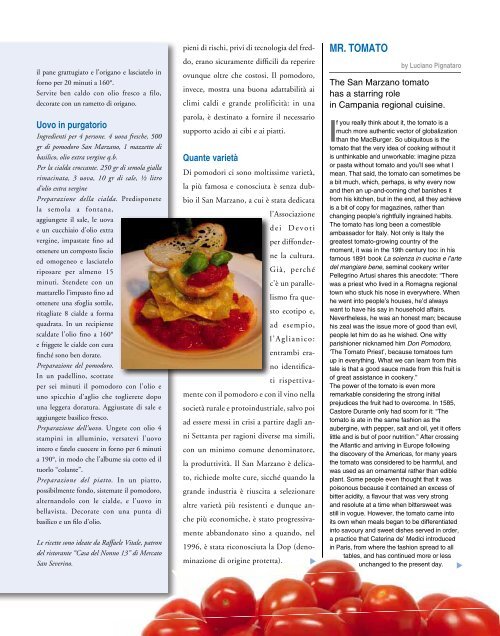COPIA OMAGGIO ⢠COMPLIMENTARY COPY EDIZIONI PRC
COPIA OMAGGIO ⢠COMPLIMENTARY COPY EDIZIONI PRC
COPIA OMAGGIO ⢠COMPLIMENTARY COPY EDIZIONI PRC
You also want an ePaper? Increase the reach of your titles
YUMPU automatically turns print PDFs into web optimized ePapers that Google loves.
il pane grattugiato e l’origano e lasciatelo in<br />
forno per 20 minuti a 160°.<br />
Servite ben caldo con olio fresco a filo,<br />
decorate con un rametto di origano.<br />
Uovo in purgatorio<br />
Ingredienti per 4 persone. 4 uova fresche, 500<br />
gr di pomodoro San Marzano, 1 mazzetto di<br />
basilico, olio extra vergine q.b.<br />
Per la cialda croccante. 250 gr di semola gialla<br />
rimacinata, 3 uova, 10 gr di sale, ½ litro<br />
d’olio extra vergine<br />
Preparazione della cialda. Predisponete<br />
la semola a fontana,<br />
aggiungete il sale, le uova<br />
e un cucchiaio d’olio extra<br />
vergine, impastate fino ad<br />
ottenere un composto liscio<br />
ed omogeneo e lasciatelo<br />
riposare per almeno 15<br />
minuti. Stendete con un<br />
mattarello l’impasto fino ad<br />
ottenere una sfoglia sottile,<br />
ritagliate 8 cialde a forma<br />
quadrata. In un recipiente<br />
scaldate l’olio fino a 160°<br />
e friggete le cialde con cura<br />
finché sono ben dorate.<br />
Preparazione del pomodoro.<br />
In un padellino, scottate<br />
per sei minuti il pomodoro con l’olio e<br />
uno spicchio d’aglio che toglierete dopo<br />
una leggera doratura. Aggiustate di sale e<br />
aggiungete basilico fresco.<br />
Preparazione dell’uovo. Ungete con olio 4<br />
stampini in alluminio, versatevi l’uovo<br />
intero e fatelo cuocere in forno per 6 minuti<br />
a 190°, in modo che l’albume sia cotto ed il<br />
tuorlo “colante”.<br />
Preparazione del piatto. In un piatto,<br />
possibilmente fondo, sistemate il pomodoro,<br />
alternandolo con le cialde, e l’uovo in<br />
bellavista. Decorate con una punta di<br />
basilico e un filo d’olio.<br />
Le ricette sono ideate da Raffaele Vitale, patron<br />
del ristorante “Casa del Nonno 13” di Mercato<br />
San Severino.<br />
pieni di rischi, privi di tecnologia del freddo,<br />
erano sicuramente difficili da reperire<br />
ovunque oltre che costosi. Il pomodoro,<br />
invece, mostra una buona adattabilità ai<br />
climi caldi e grande prolificità: in una<br />
parola, è destinato a fornire il necessario<br />
supporto acido ai cibi e ai piatti.<br />
Quante varietà<br />
Di pomodori ci sono moltissime varietà,<br />
la più famosa e conosciuta è senza dubbio<br />
il San Marzano, a cui è stata dedicata<br />
l’Associazione<br />
dei Devoti<br />
per diffonderne<br />
la cultura.<br />
Già, perché<br />
c’è un parallelismo<br />
fra questo<br />
ecotipo e,<br />
ad esempio,<br />
l’Aglianico:<br />
entrambi erano<br />
identificati<br />
rispettivamente<br />
con il pomodoro e con il vino nella<br />
società rurale e protoindustriale, salvo poi<br />
ad essere messi in crisi a partire dagli anni<br />
Settanta per ragioni diverse ma simili,<br />
con un minimo comune denominatore,<br />
la produttività. Il San Marzano è delicato,<br />
richiede molte cure, sicché quando la<br />
grande industria è riuscita a selezionare<br />
altre varietà più resistenti e dunque anche<br />
più economiche, è stato progressivamente<br />
abbandonato sino a quando, nel<br />
1996, è stata riconosciuta la Dop (denominazione<br />
di origine protetta).<br />
<br />
MR. TOMATO<br />
by Luciano Pignataro<br />
The San Marzano tomato<br />
has a starring role<br />
in Campania regional cuisine.<br />
If you really think about it, the tomato is a<br />
much more authentic vector of globalization<br />
than the MacBurger. So ubiquitous is the<br />
tomato that the very idea of cooking without it<br />
is unthinkable and unworkable: imagine pizza<br />
or pasta without tomato and you’ll see what I<br />
mean. That said, the tomato can sometimes be<br />
a bit much, which, perhaps, is why every now<br />
and then an up-and-coming chef banishes it<br />
from his kitchen, but in the end, all they achieve<br />
is a bit of copy for magazines, rather than<br />
changing people’s rightfully ingrained habits.<br />
The tomato has long been a comestible<br />
ambassador for Italy. Not only is Italy the<br />
greatest tomato-growing country of the<br />
moment, it was in the 19th century too: in his<br />
famous 1891 book La scienza in cucina e l’arte<br />
del mangiare bene, seminal cookery writer<br />
Pellegrino Artusi shares this anecdote: “There<br />
was a priest who lived in a Romagna regional<br />
town who stuck his nose in everywhere. When<br />
he went into people’s houses, he’d always<br />
want to have his say in household affairs.<br />
Nevertheless, he was an honest man; because<br />
his zeal was the issue more of good than evil,<br />
people let him do as he wished. One witty<br />
parishioner nicknamed him Don Pomodoro,<br />
‘The Tomato Priest’, because tomatoes turn<br />
up in everything. What we can learn from this<br />
tale is that a good sauce made from this fruit is<br />
of great assistance in cookery.”<br />
The power of the tomato is even more<br />
remarkable considering the strong initial<br />
prejudices the fruit had to overcome. In 1585,<br />
Castore Durante only had scorn for it: “The<br />
tomato is ate in the same fashion as the<br />
aubergine, with pepper, salt and oil, yet it offers<br />
little and is but of poor nutrition.” After crossing<br />
the Atlantic and arriving in Europe following<br />
the discovery of the Americas, for many years<br />
the tomato was considered to be harmful, and<br />
was used as an ornamental rather than edible<br />
plant. Some people even thought that it was<br />
poisonous because it contained an excess of<br />
bitter acidity, a flavour that was very strong<br />
and resolute at a time when bittersweet was<br />
still in vogue. However, the tomato came into<br />
its own when meals began to be differentiated<br />
into savoury and sweet dishes served in order,<br />
a practice that Caterina de’ Medici introduced<br />
in Paris, from where the fashion spread to all<br />
tables, and has continued more or less<br />
unchanged to the present day.



